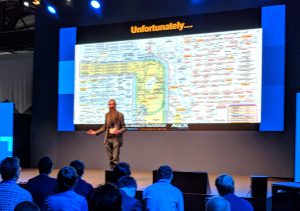[liveblog] Aubrey de Grey
I’m at the CUBE Tech conference in Berlin. (I’m going to give a first keynote on the book I’m finishing.) Aubrey de Grey begins his keynote begins by changing the question from “Who wants to get old?” to “Who wants Alzheimers?” because we’ve been brainwashed into thinking that aging is somehow good for us: we get wiser, get to retire, etc. Now we are developing treatments for aging. Ambiguity about aging is now “hugely damaging” because it hinders the support of research. E.g., his SENS Research Foundation is going too slowly because of funding restraints.
|
NOTE: Live-blogging. Getting things wrong. Missing points. Omitting key information. Introducing artificial choppiness. Over-emphasizing small matters. Paraphrasing badly. Not running a spellpchecker. Mangling other people’s ideas and words. You are warned, people. |
“The defeat of aging via medicine is foreseseeable now.” He says he has to be credible because people have been saying this forever and have been wrong.
“Why is aging still a problem?” One hundred years ago, a third of babies would die before they were one year old. We fixed this in the industrialized world through simple advances, e.g., hygiene, mosquito, antibiotics. So why are diseases of old age so much harder to control? People think it’s because so many things go wrong with us late in life, interacting with one another and creating incredible complexity. But that’s not the main answer.
“Aging is easy to define: it is a side effect of being alive.” “It’s a fact of the operation of the human body generates damage.” It accumulates. The body tolerates a certain amount. When you pass that amount, you get pathologies of old age. Our approach has been to develop geriatric medicine to counteract those pathologies. That’s where most of the research goes.
But that won’t work because the damage continues. Geriatric medicine bangs away at the pathologies, but will necessarily become less effective over time. “We make this mistake because of a misclassification we make.”
If you ask people to make categories of disease, they’ll come up with communicable, congenital, and chronic. Then most people add a fourth way of being sick: aging itself. It includes fraility, sarcopenia (loss of muscle), immunosenesence (aging of the immune system)…But that’s silly. Aging in a living organism is the same as aging in a machine. “Aging is the accumulation of damage that occurs as a side-effect of the body’s normal operation.”It is the accumulation of damage to the body that occurs as an intrinsic side-effect of the body’s normal operation. That means the categories are right, except aging covers column 3 and 4. Column 3 — specific diseases such as alzheimer’s and cancer — is also part aging. This means that aging isn’t a blessing in surprise, and that we can’t say that column 3 are high-priorities of medicine but those in 4 are not.
A hundred years ago a few people started to think about this and realized that if we tried to interfere with the process of aging earlier one, we’d do better. This became the field of gerontology. Some species age much more slowly than others. Maybe we can figure out the basis for that variation. But the metabolism is really really complicated. “This is the ultimate nightmare of uncommented spaghetti code.” We know so little about how the body works.
“There is another approach. And it’s completely bleeding obvious”: Periodically repair the damage. We don’t need to slow down the rate at which metabolism causes damage. We need to engineer a system we don’t understand. But “we don’t need to understand how metabolism causes damag”we don’t need to understand how metabolism causes damage. Nor do we need to know what to do when the damage is too great, because we’re not going to let it get to that state. We do this with, say, antique cars. Preventitive maintenance works. “The only question is, can we do it for a much more complicated machine like the human body?
“We’re sidestepping our ignorance of metabolism and pathology. But we have to cope with the fact that damage is complicated” All of the types of damage, from cell loss toe extracellular matrix stiffening — there are 7 categories — can be repaired through a single approach: genetic repair. E.g., loss of cells can be repaired by replacing them using stem cells. Unfortunately, most of the funding is going only to this first category. SENS was created to enable research on the other seven. Aubrey talks about SENS’ work on protecting cells from the bad effects of cholesterol.
He points to another group (unnamed) that has reinvented this approach and is getting a lot of notice.
He says longevity is not what people think it is. These therapies will let people stay alive longer, but they will also stay youthful longer. “”Longevity is a side effect of health.” ”“Longevity is a side effect of health.”
Will this be only for the rich? Overpopulation? Boredom? Pensions collapse? We’re taking care of overpopulation by cleaning up its effects, he says. He says there are solutions to these problems. But there are choices we have to make. No one wants to get Alzheimers. We can’t have it both ways. Either we want to keep people healthy or not.
He says SENS has been successful enough that they’ve been able to spin out some of the research into commercial operations. But we need to cary on in the non-profit research world as well. Project 21 aims at human rejuvenation clinical trials.










